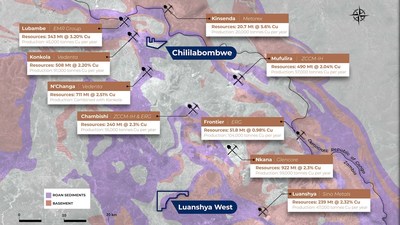Deep-South Resources Inc. announces that the Environmental Project Briefs (“EPB”) submitted to the Zambia Environmental Management Agency (“ZEMA”) have been approved. The team started mobilizing on Tuesday November 8 and will start the soil sampling program on the three licences.
The program:


The program consists of geochemical soil sampling on each licence with the aim of identify anomalies and defining drilling targets.
Luanshya West Project (licence 23246):
The licence is situated in the center of the Zambian Copper belt and covers 5,423.26 hectares (54.24 Sq. Km). The project prospectivity is based on the location of the property over the unconformable contact between the basement granites and the Lower Roan Group sediments where most copper belt mines in both Zambia and the Democratic Republic of Congo (the “DRC”) are located.
Historically, some 850 soil samples and geophysical data were collected over the property by Teal (a subsidiary of African Rainbow Minerals Ltd) between 2007 and 2009. This data has enabled DSM to identify at least four large anomalies. The goal of the sampling program is to generate new geochemical data (verify the old data) and to delineate drilling targets over the anomalies identified.
The program consists of 820 soil samples collected in an identical manner to the original Teal sampling program. The sampling grid will be 500 x 100 metres, duplicating the old grid with the addition of some extra samples in areas not previously sampled (holes in the grid). The program will be completed in about 30 days.
The project area is close to established copper / cobalt mines with Chibuluma mine some 35Km to the north-east, Chambishi mine 41Km north-northeast, N’changa mine 53Km north-northwest and Luanshya mine some 40Km east-southeast from the centre of the project area.
A National Instrument 43-101 Standards of Disclosure for Mineral Projects (“43-101”) compliant technical qualifying report is available on SEDAR at www.sedar.com under Deep-South’s profile or on the Company’s web site: www.deepsouthresources.com
Chililabombwe Project (licence 23247):
The licence is situated in the north of the Zambia Copper belt near the DRC border. The Large Exploration Licence covers 2,200 hectares (22.5 Sq, Km). The project prospectivity is based on the location of the property over the unconformable contact zone between the basement granites and the Lower Roan Group sediments where most copper belt mines in both Zambia and the DRC are located.
The program consists of 132 soil samples on a grid of 500m by 100m. The soil-geochemistry survey should locate any copper anomalies within the area. In this particular area, due to their abundance, termite mounds will be sampled rather than digging sample holes. This is because termites bring material to the surface from considerable depth and therefore generate a deeper sampling profile.
Mpongwe Project (licence 23248). This licence is situated in the center of the Zambian Copper belt. The Large Exploration Licence covers 67,500 hectares (675 Sq. Km). The project is considered prospective as it is again located over the unconformable contact zone between basement granites and the Lower Roan Group sediments where most copper belt mines in both Zambia and the DRC are located.
The program consists of 2,675 soil samples on a grid of 500m by 100m. It has been designed to search for copper anomalies using a soil-geochemistry survey.
Qualified Person
Vivian Suart-Willams MSc (Hons.) Pr.Sci.Nat., Vice-President Exploration of Deep-South Resources, has reviewed the technical content of this presentation, and is the designated Qualified Person under the terms of National Instrument 43-101. Mr. Stuart-Williams is responsible for the technical part of this press release.
Deep-South Resources is a mineral exploration and development company. Deep-South’s growth strategy is to focus on the exploration and development of quality assets in significant mineralized trends and in proximity to infrastructure in stable countries. In using and assessing environmentally friendly technologies in the development of its copper project, Deep-South embraces the green revolution.